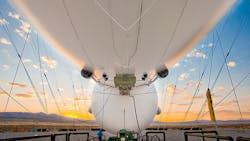Another weapon in the arsenal, so to speak, to protect the U.S. against cruise missiles and other air-related threats comes via Raytheon in the form of a blimp-borne radar system. Previously only used for testing, the airborne radar system is now strategically ready for deployment. The Joint Land Attack Cruise Missile Defense Elevated Netted Sensor (JLENS) system integrates with current land-, sea-, and air-based defenses that detect and intercept potential threats.
The JLENS system, capable of floating at altitudes as high as 10,000 feet, is suspended from two 80-yard long, helium-filled, blimp-like aerostats that are tethered to ground stations via a rugged cable. Those tethers allow JLENS to stay in the air for up to 30 days at a time. Affixing the radar to an aerostat produces two major advantages: longer-distance viewing due to the higher altitude, and persistence since it can stay in the air much longer than other airborne systems.
JLENS consists of both integrated 360° surveillance radar and a fire-control radar that can detect and target threats up to 340 statute miles away. The over-the-horizon sensor system allows for defense against hostile cruise missiles, low-flying manned and unmanned aircraft, and moving surface vehicles, as well as the detection of tactical ballistic missiles and large-caliber rockets. JLENS has already demonstrated its ability to integrate with a variety of defensive systems, including the Patriot, Advanced Medium-Range Air-to-Air Missile (AMRAAM), and Standard Missile 6.

